Coupling Rainfall Intensity and Satellite-Derived Soil Moisture for Time of Concentration Prediction: A Data-Driven Hydrological Approach to Enhance Climate Responsiveness
Abstract
1. Introduction
2. Materials and Methods
2.1. Study Area
2.2. Hydro-Meteorological and Remote Sensing Data Collection & Preprocessing
2.3. Event Selection
2.4. Estimating Time of Concentration—DMCA-Based Approach
2.5. Improving Time of Concentration Estimation: Integrating Soil Moisture
2.6. Hydrological Modelling—HEC-HMS
3. Results
3.1. DMCA-Based Time of Concentration Estimation
3.2. Refining Rainfall Intensity-Time of Concentration Relationships Through SMAP Soil Moisture Data
3.3. Comparison of Hydrograph Responses Using Conventional and Modified Tc Approaches
3.4. Sensitivity Analysis
4. Discussion
5. Conclusions
Author Contributions
Funding
Data Availability Statement
Acknowledgments
Conflicts of Interest
Appendix A
| Streamflow Gauge Station | Coordinates | Temporal Resolution | |
|---|---|---|---|
| Longitude (°E) | Latitude (°N) | ||
| Ratnapura | 80.40 | 6.68 | Hourly |
| Rainfall Gauge Station | Coordinates | Temporal Resolution | |
|---|---|---|---|
| Longitude (°E) | Latitude (°N) | ||
| Alupolla | 80.58 | 6.72 | Daily |
| Balangoda | 80.70 | 6.65 | Daily |
| Wellandura | 80.57 | 6.53 | Daily |
| Ratnapura | 80.40 | 6.68 | Daily |
Appendix B
| Criteria | Applied Method | Parameter | Ratnapura Sub-Basin |
|---|---|---|---|
| Canopy | Simple canopy | Initial Storage (%) | 100 |
| Max Storage (mm) | 15 | ||
| Crop Coefficient | 1 | ||
| Surface | Simple Surface | Initial Storage (%) | 100 |
| Max Storage (mm) | 0.1 | ||
| Loss | SCS Curve Number | Initial Abstraction (mm) | 1 |
| Curve Number | 76 | ||
| Impervious (%) | 3 | ||
| Transform | SCS Unit Hydrograph | Lag Time (min) | 255 |
| Base flow | Recession | Initial Discharge (m3/s) | Event Dependent |
| Recession Constant | 0.6 | ||
| Threshold Type | Ratio to Peak | ||
| Ratio | 0.9 |
Appendix C
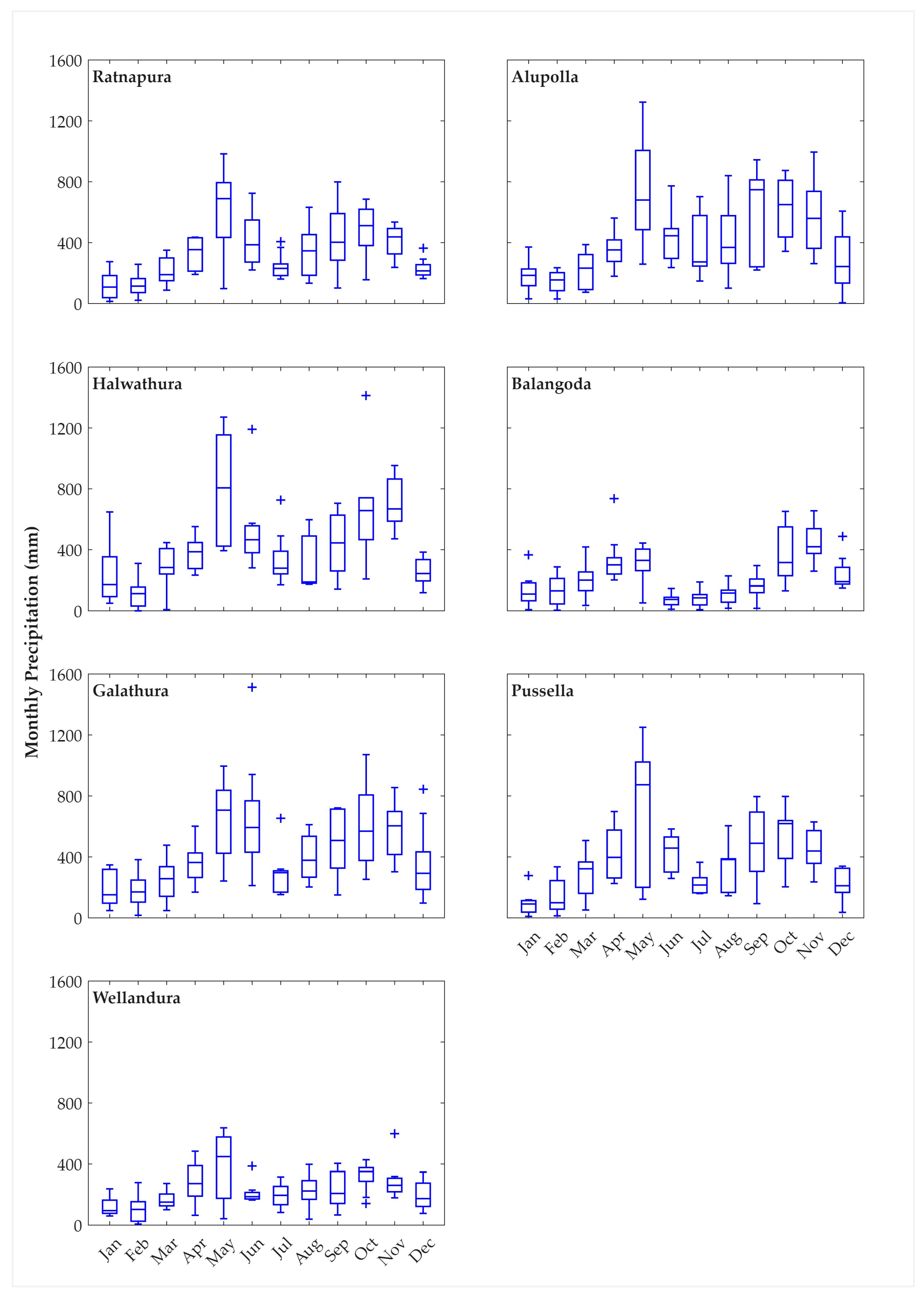

References
- Grimaldi, S.; Petroselli, A.; Tauro, F.; Porfiri, M. Time of concentration: A paradox in modern hydrology. Hydrol. Sci. J. 2012, 57, 217–228. [Google Scholar] [CrossRef]
- Piadeh, F.; Behzadian, K.; Alani, A.M. A Critical Review of Real-Time Modelling of Flood Forecasting in Urban Drainage Systems. J. Hydrol. 2022, 607, 127476. [Google Scholar] [CrossRef]
- Chow, V.T.; Maidment, D.R.; Mays, L.W. Applied Hydrology; McGraw-Hill International Editions; McGraw-Hill: Columbus, OH, USA, 1988; ISBN 9780070108103. [Google Scholar]
- Fang, X.; Thompson, D.B.; Cleveland, T.G.; Pradhan, P.; Malla, R. Time of Concentration Estimated Using Watershed Parameters Determined by Automated and Manual Methods. J. Irrig. Drain. Eng. 2008, 134, 202–211. [Google Scholar] [CrossRef]
- Wadhwa, A.; Kummamuru, P.K. A Study on the Effectiveness of Percolation Ponds as a Stormwater Harvesting Alternative for a Semi-Urban Catchment. AQUA Water Infrastruct. Ecosyst. Soc. 2021, 70, 184–201. [Google Scholar] [CrossRef]
- Michailidi, E.M.; Antoniadi, S.; Koukouvinos, A.; Bacchi, B.; Efstratiadis, A. Timing the Time of Concentration: Shedding Light on a Paradox. Hydrol. Sci. J. 2018, 63, 721–740. [Google Scholar] [CrossRef]
- Feldman, A.D. Hydrologic Modeling System HEC-HMS: Technical Reference Manual; US Army Corps of Engineers, Hydrologic Engineering Center: Davis, CA, USA, 2000.
- Alamri, N.; Afolabi, K.; Ewea, H.; Elfeki, A. Evaluation of the Time of Concentration Models for Enhanced Peak Flood Estimation in Arid Regions. Sustainability 2023, 15, 1987. [Google Scholar] [CrossRef]
- Costabile, P.; Barbero, G.; Nagy, E.D.; Négyesi, K.; Petaccia, G.; Costanzo, C. Predictive Capabilities, Robustness and Limitations of Two Event-Based Approaches for Lag Time Estimation in Heterogeneous Watersheds. J. Hydrol. 2024, 642, 131814. [Google Scholar] [CrossRef]
- Gericke, O.J.; Smithers, J.C. Direct Estimation of Catchment Response Time Parameters in Medium to Large Catchments Using Observed Streamflow Data. Hydrol. Process 2017, 31, 1125–1143. [Google Scholar] [CrossRef]
- WMO; OMM; VMO. International Glossary of Hydrology =: Glossaire International D’hydrologie = [Mezhdunarodnyĭ Gidrologicheskiĭ Slovarʹ] = Glosario Hidrológico Internacional, 1st ed.; WMO/Unesco Panel on Terminology, Ed.; Secretariat of the World Meteorological Organization: Geneva, Switzerland, 1974; ISBN 9789263003850. [Google Scholar]
- McCuen, R.H. Uncertainty Analyses of Watershed Time Parameters. J. Hydrol. Eng. 2009, 14, 490–498. [Google Scholar] [CrossRef]
- Beven, K.J. A History of the Concept of Time of Concentration. Hydrol. Earth Syst. Sci. 2020, 24, 2655–2670. [Google Scholar] [CrossRef]
- KC, M.; Fang, X. Estimating Time Parameters of Overland Flow on Impervious Surfaces by the Particle Tracking Method. Hydrol. Sci. J. 2015, 60, 294–310. [Google Scholar] [CrossRef]
- Mockus, V. Watershed Lag. US Dept. Agric. Soil Conserv. Serv. 1961, 3, 275–370. [Google Scholar]
- Snyder, F.F. Synthetic Unit-Graphs. Eos Trans. Am. Geophys. Union 1938, 19, 447–454. [Google Scholar]
- Kirpich, Z.P. Time of Concentration of Small Agricultural Watersheds. Civil. Eng. 1940, 10, 362. [Google Scholar]
- Williams, J.R.; Hann, R.W. Hymo, A Problem-Oriented Computer Language for Building Hydrologic Models. Water Resour. Res. 1972, 8, 79–86. [Google Scholar] [CrossRef]
- Li, M.-H.; Chibber, P. Overland Flow Time of Concentration on Very Flat Terrains. Transp. Res. Rec. 2008, 2060, 133–140. [Google Scholar] [CrossRef]
- USDA NRCS (United States Department of Agriculture Natural Resources Conservation Service). Time of Concentration. In National Engineering Handbook; United States Department of Agriculture Natural Resources Conservation Service: Washington, DC, USA, 2010; pp. 1–18. [Google Scholar]
- Morgali, J.R.; Linsley, R.K. Computer Simulation of Overland Flow. J. Hydraul. Div. ASCE 1965, 91, 81–100. [Google Scholar] [CrossRef]
- Welle, P.I.; Woodward, D. Engineering Hydrology. In Time of Concentration; Technical Note. US Department of Agriculture, Soil Conservation Service. Pennsylvania; Natural Resources Conservation Service: Washington, DC, USA, 1986; Volume 4, p. 13. [Google Scholar]
- Espey, W.H.; Winslow, D.E. The Effects of Urbanization on Unit Hydrographs for Small Watersheds, Houston, Texas, 1964–1967; REP BY TRACOR, SEPT 1968; The Office of Water Resources Research, U.S. Department of the Interior: Washington, DC, USA, 1964.
- Thomas, W.O.; Monde, M.C.; Davis, S.R. Estimation of Time of Concentration for Maryland Streams. Transp. Res. Rec. 2000, 1720, 95–99. [Google Scholar] [CrossRef]
- Sabol, G. V Hydrologic Basin Response Parameter Estimation Guidelines; State of Colorado Office of the State Engineer, Dam Safety Branch: Denver, CO, USA, 2008. [Google Scholar]
- McCuen, R.H.; Wong, S.L.; Rawls, W.J. Estimating Urban Time of Concentration. J. Hydraul. Eng. 1984, 110, 887–904. [Google Scholar] [CrossRef]
- Espey, W.H.; Altman, D.G. Urban Runoff Control Planning: Nomographs for 10 Minute Unit Hydrographs for Small Watersheds; American Society of Civil Engineers: Reston, VA, USA, 1978. [Google Scholar]
- Gericke, O.J.; Smithers, J.C. Review of Methods Used to Estimate Catchment Response Time for the Purpose of Peak Discharge Estimation. Hydrol. Sci. J. 2014, 59, 1935–1971. [Google Scholar] [CrossRef]
- Wong, T.S.W. Formulas for Time of Travel in Channel with Upstream Inflow. J. Hydrol. Eng. 2001, 6, 416–422. [Google Scholar] [CrossRef]
- Liang, J.; Melching, C.S. Comparison of Computed and Experimentally Assessed Times of Concentration for a V-Shaped Laboratory Watershed. J. Hydrol. Eng. 2012, 17, 1389–1396. [Google Scholar] [CrossRef]
- Sultan, D.; Tsunekawa, A.; Tsubo, M.; Haregeweyn, N.; Adgo, E.; Meshesha, D.T.; Fenta, A.A.; Ebabu, K.; Berihun, M.L.; Setargie, T.A. Evaluation of Lag Time and Time of Concentration Estimation Methods in Small Tropical Watersheds in Ethiopia. J. Hydrol. Reg. Stud. 2022, 40, 101025. [Google Scholar] [CrossRef]
- Usda, S. Urban Hydrology for Small Watersheds; Technical release; Natural Resources Conservation Service: Washington, DC, USA, 1986; Volume 55, pp. 2–6. [Google Scholar]
- Srivastava, P.K. Satellite Soil Moisture: Review of Theory and Applications in Water Resources. Water Resour. Manag. 2017, 31, 3161–3176. [Google Scholar] [CrossRef]
- Xiong, L.; Zeng, L. Impacts of Introducing Remote Sensing Soil Moisture in Calibrating a Distributed Hydrological Model for Streamflow Simulation. Water 2019, 11, 666. [Google Scholar] [CrossRef]
- Loizu, J.; Massari, C.; Álvarez-Mozos, J.; Tarpanelli, A.; Brocca, L.; Casalí, J. On the Assimilation Set-up of ASCAT Soil Moisture Data for Improving Streamflow Catchment Simulation. Adv. Water Resour. 2018, 111, 86–104. [Google Scholar] [CrossRef]
- Pabasara, K.; Gunawardhana, L.; Bamunawala, J.; Sirisena, J.; Rajapakse, L. Significance of Multi-Variable Model Calibration in Hydrological Simulations within Data-Scarce River Basins: A Case Study in the Dry-Zone of Sri Lanka. Hydrology 2024, 11, 116. [Google Scholar] [CrossRef]
- Srimali, A.; Gunawardhana, L.; Bamunawala, J.; Sirisena, J.; Rajapakse, L. Impact of Spatio-Temporal Variability of Droughts on Streamflow: A Remote-Sensing Approach Integrating Combined Drought Index. Hydrology 2025, 12, 142. [Google Scholar] [CrossRef]
- Wang, J.; Zhai, P.; Li, C. Non-Uniform Changes of Daily Precipitation in China: Observations and Simulations. Weather Clim. Extrem. 2024, 44, 100665. [Google Scholar] [CrossRef]
- Nandalal, K.D.W. Use of a Hydrodynamic Model to Forecast Floods of Kalu River in Sri Lanka. J. Flood Risk Manag. 2009, 2, 151–158. [Google Scholar] [CrossRef]
- Ampitiyawatta, A.; Guo, S. Precipitation Trends in the Kalu Ganga Basin in Sri Lanka. J. Agric. Sci. 2010, 4(1), 10–18. [Google Scholar] [CrossRef]
- Irrigation Department. Hydrological Annual of Sri Lanka 2021/22; Irrigation Department: Colombo, Sri Lanka, 2024.
- Müller-Thomy, H.; Wallner, M.; Förster, K. Rainfall disaggregation for hydrological modeling: Is there a need for spatial consistence? Hydrol. Earth Syst. Sci. 2018, 22, 5259–5280. [Google Scholar] [CrossRef]
- Al Janabi, F.; Bista, A.; Helm, B.; Krebs, P.; Bernhofer, C. Temporal Disaggregation of Daily Precipitation for Hydrological Modelling under Data Scarcity Conditions by Using Data from Neighboring Station as a Reference for Chaohu, China. In Proceedings of the EGU General Assembly Conference Abstracts, Vienna, Austria, 23–28 April 2017; p. 4967. [Google Scholar]
- Giani, G.; Rico-Ramirez, M.A.; Woods, R.A. A Practical, Objective, and Robust Technique to Directly Estimate Catchment Response Time. Water Resour. Res. 2021, 57, e2020WR028201. [Google Scholar] [CrossRef]
- Li, X.-F.; Blenkinsop, S.; Barbero, R.; Yu, J.; Lewis, E.; Lenderink, G.; Guerreiro, S.; Chan, S.; Li, Y.; Ali, H.; et al. Global Distribution of the Intensity and Frequency of Hourly Precipitation and Their Responses to ENSO. Clim. Dyn. 2020, 54, 4823–4839. [Google Scholar] [CrossRef]
- Gu, G.; Adler, R.F. Precipitation Intensity Changes in the Tropics from Observations and Models. J. Clim. 2018, 31, 4775–4790. [Google Scholar] [CrossRef]
- Gimeno, L.; Sorí, R.; Vázquez, M.; Stojanovic, M.; Algarra, I.; Eiras-Barca, J.; Gimeno-Sotelo, L.; Nieto, R. Extreme Precipitation Events. WIREs Water 2022, 9, e1611. [Google Scholar] [CrossRef]
- Kristoufek, L. Power-Law Correlations in Finance-Related Google Searches, and Their Cross-Correlations with Volatility and Traded Volume: Evidence from the Dow Jones Industrial Components. Phys. A Stat. Mech. Its Appl. 2015, 428, 194–205. [Google Scholar] [CrossRef]
- Kristoufek, L. Detrending Moving-Average Cross-Correlation Coefficient: Measuring Cross-Correlations between Non-Stationary Series. Phys. A Stat. Mech. Its Appl. 2014, 406, 169–175. [Google Scholar] [CrossRef]
- Giani, G.; Tarasova, L.; Woods, R.A.; Rico-Ramirez, M.A. An Objective Time-Series-Analysis Method for Rainfall-Runoff Event Identification. Water Resour. Res. 2022, 58, e2021WR031283. [Google Scholar] [CrossRef]
- Gong, J.; Yao, C.; Li, Z.; Chen, Y.; Huang, Y.; Tong, B. Improving the Flood Forecasting Capability of the Xinanjiang Model for Small- and Medium-Sized Ungauged Catchments in South China. Nat. Hazards 2021, 106, 2077–2109. [Google Scholar] [CrossRef]
- Schmidt, E.J.; Schulze, R.E. Improved Estimates of Peak Flow Rates Using Modified SCS Lag Equations; University of Natal, Department of Agricultural Engineering: Pietermaritzburg, South Africa, 1984. [Google Scholar]
- Kadoya, M.; Fukushima, A. Concentration Time of Flood Runoff in Smaller River Basins. In Proceedings of the 3rd International Hydrology Symposium on Theoretical and Applied Hydrology, Fort Collins, CO, USA, 27–29 July 1977; pp. 75–88. [Google Scholar]
- Fang, X.; Cleveland, T.G.; Garcia, C.A.; Thompson, D.B.; Malla, R. Estimating Timing Parameters of Direct Runoff and Unit Hydrographs for Texas Watersheds; Texas Department of Transportation: Austin, TX, USA, 2005. [Google Scholar]
- Simas, M.J.C. Lag-Time Characteristics in Small Watersheds in the United States; The University of Arizona: Tucson, AZ, USA, 1996. [Google Scholar]
- Bondelid, T.; McCuen, R.; Jackson, T. Sensitivity of SCS Models to Curve Number Variation1. J. Am. Water Resour. Assoc. 2007, 18, 111–116. [Google Scholar] [CrossRef]
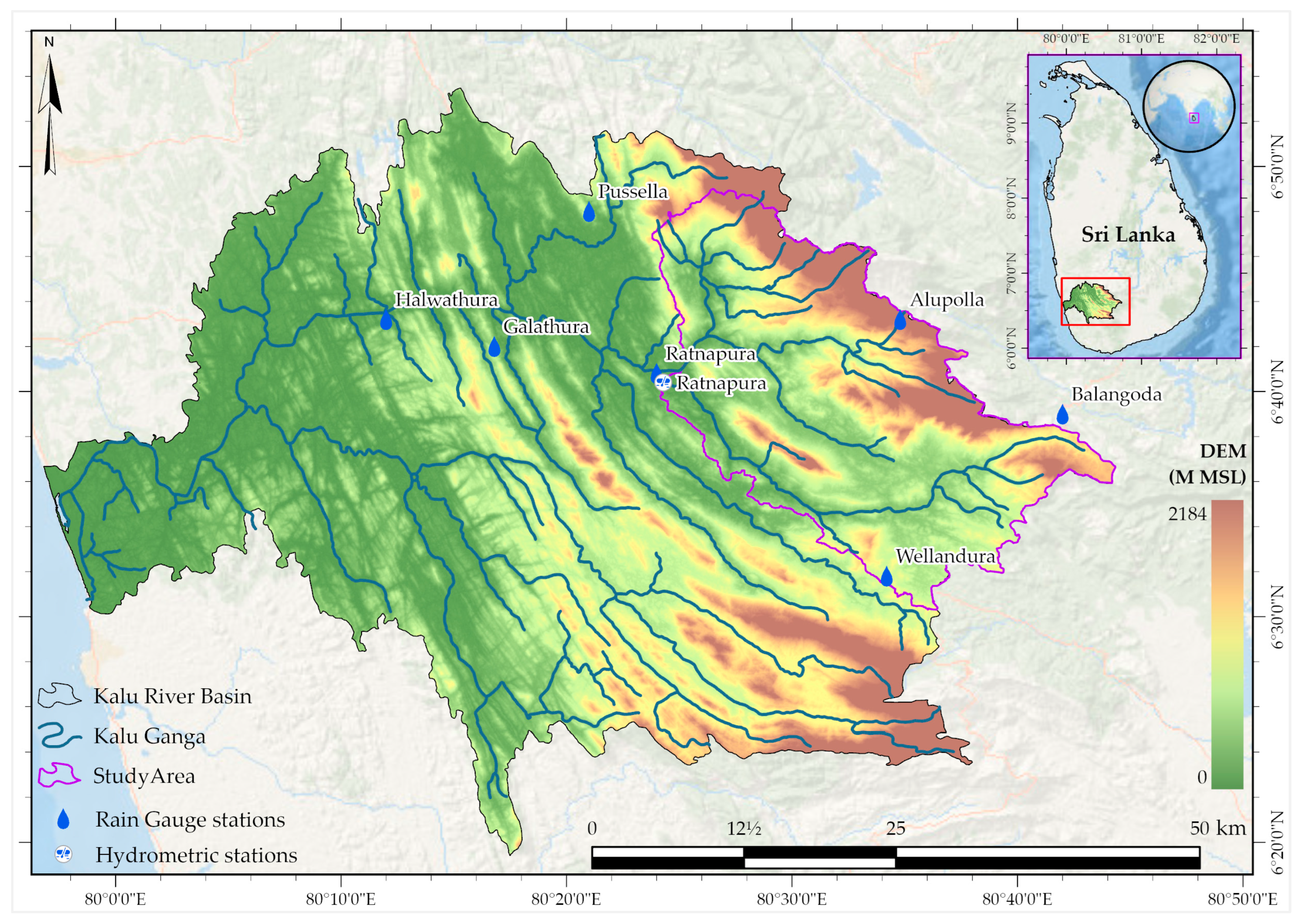
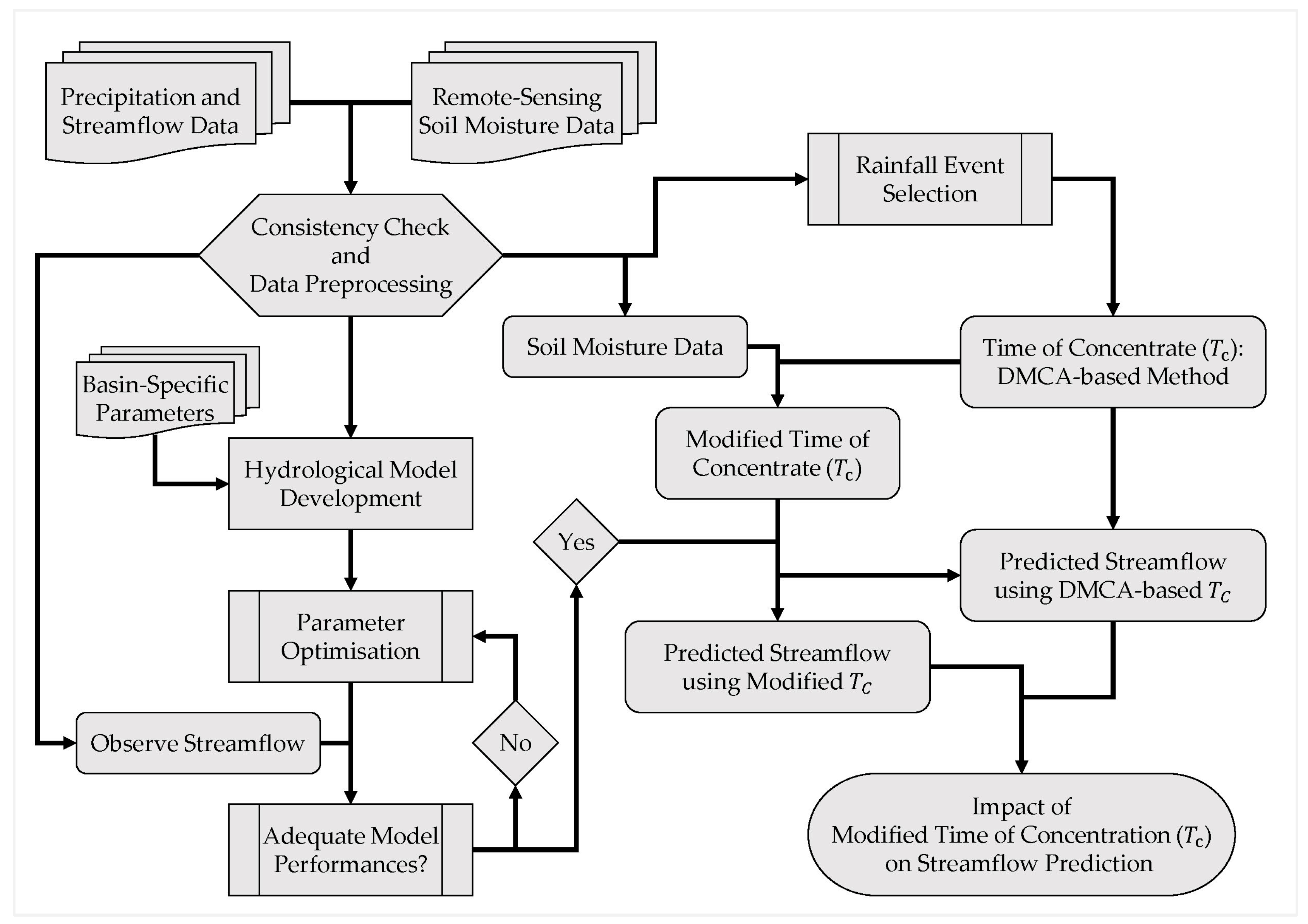
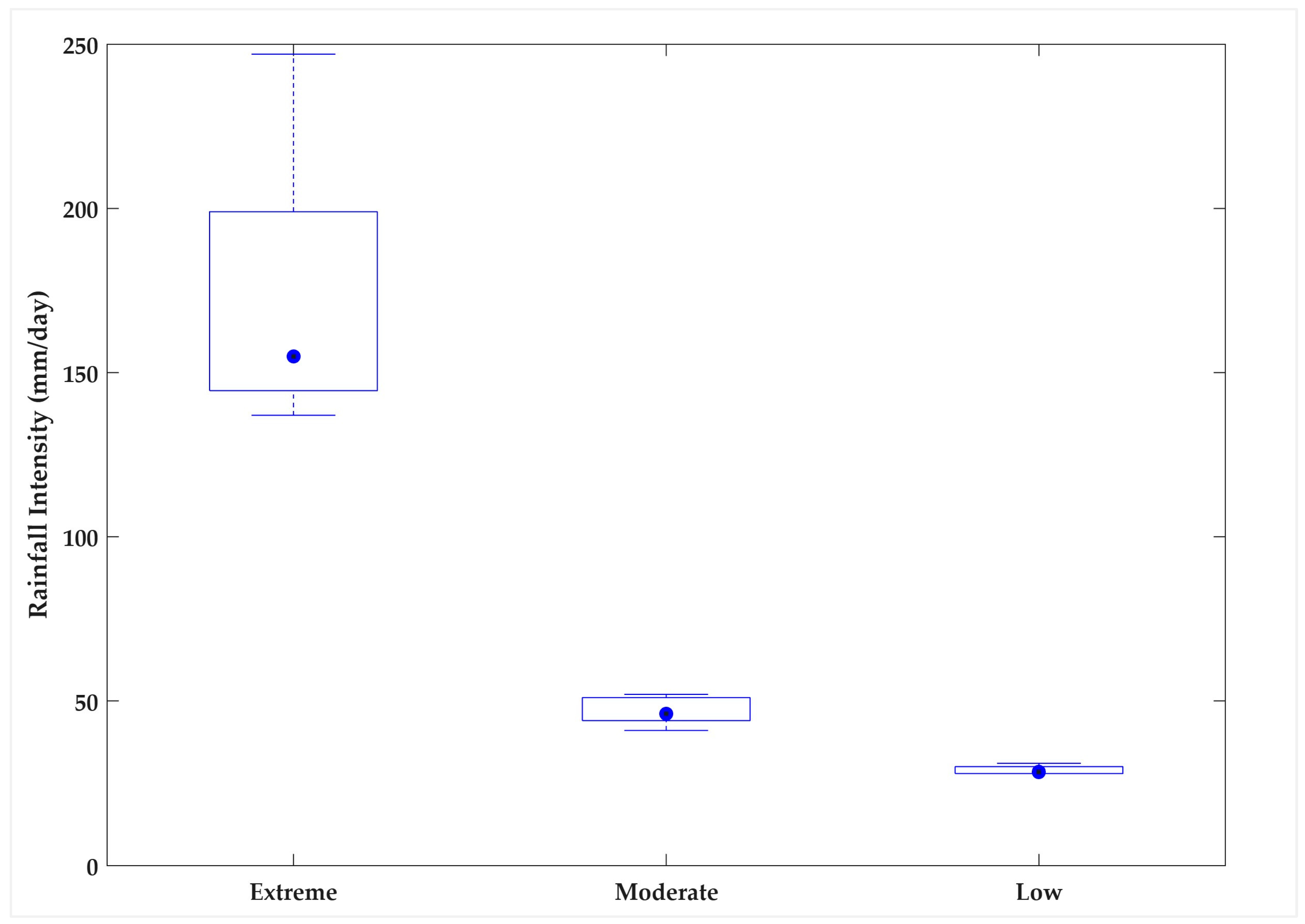

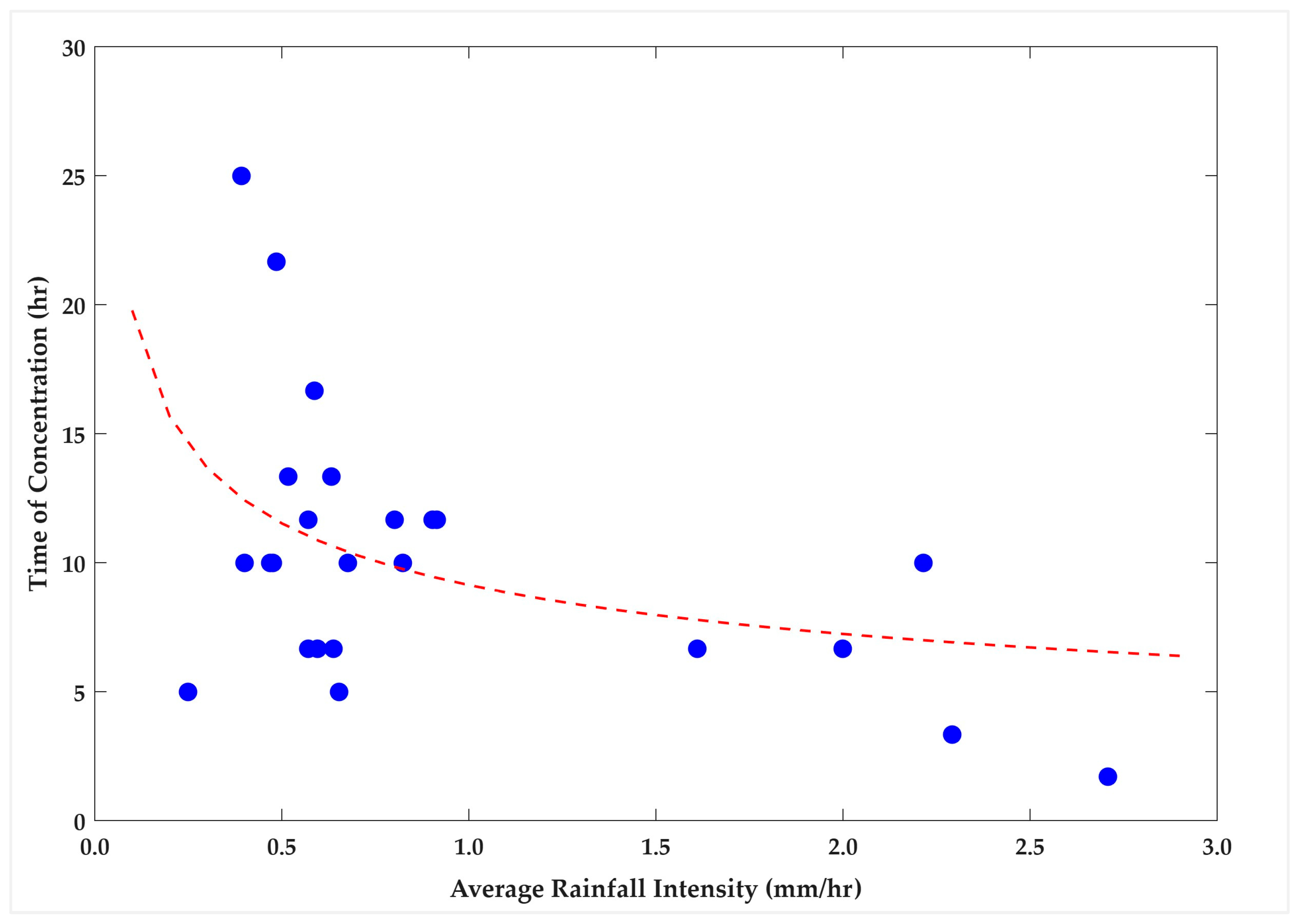
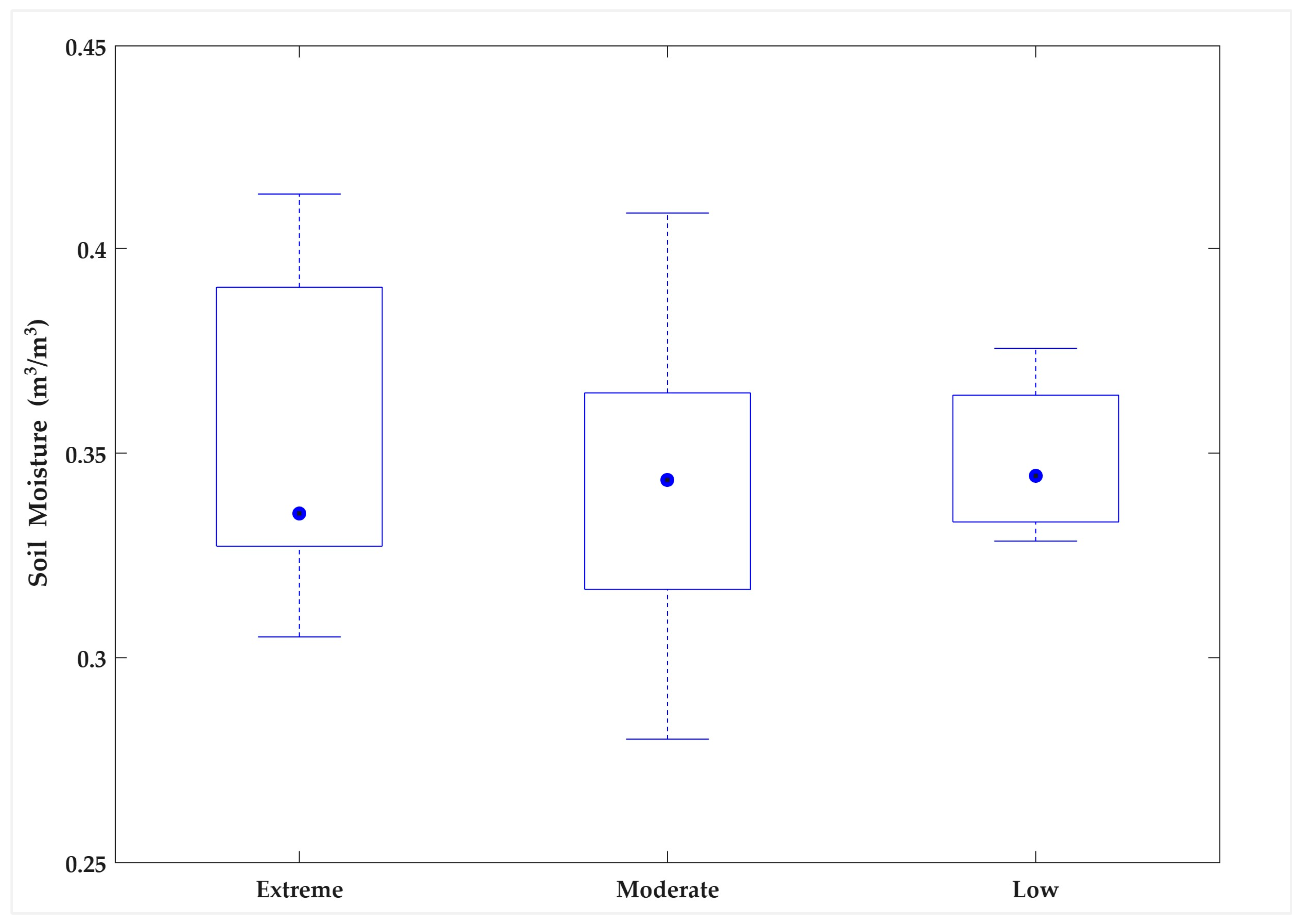
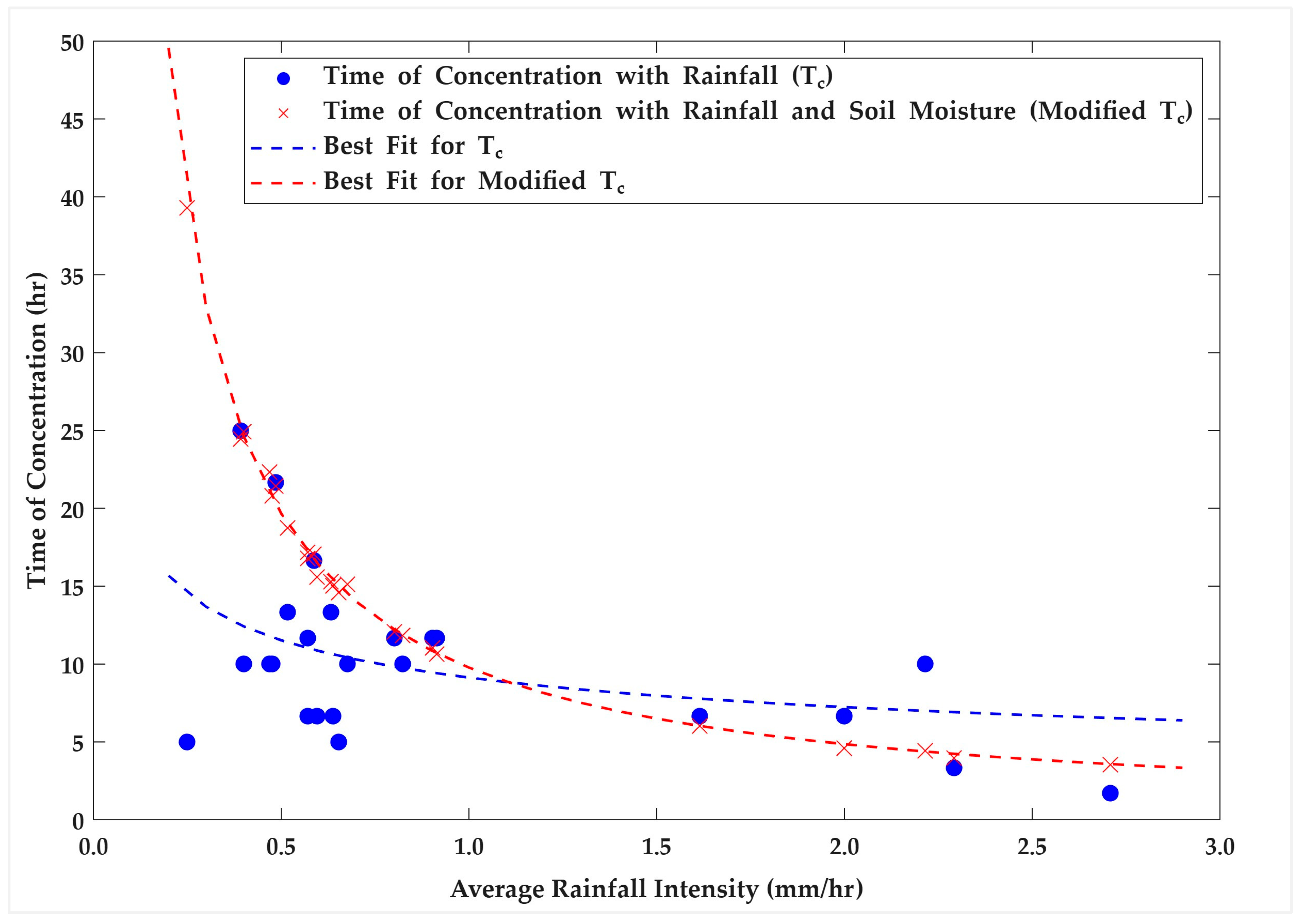
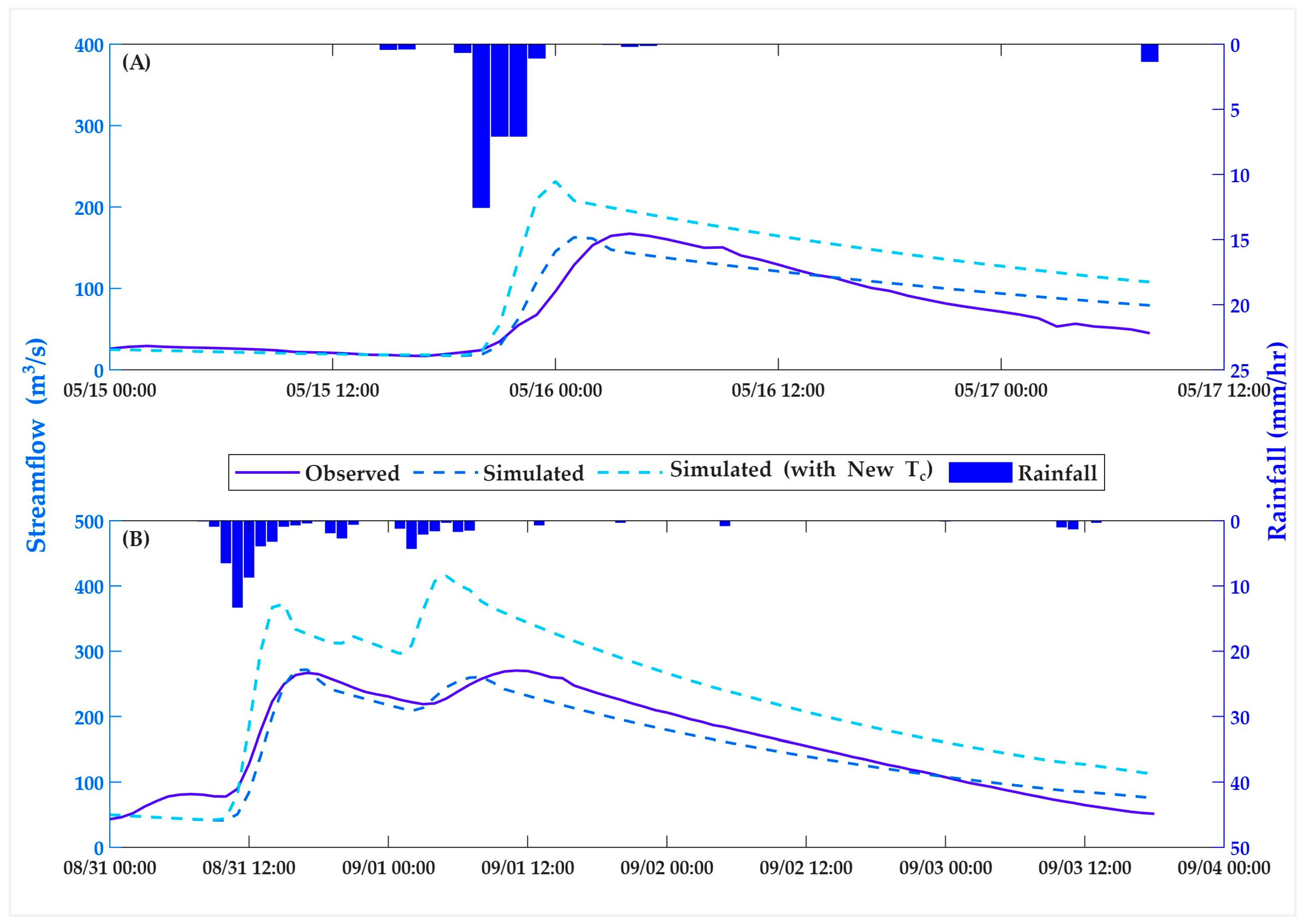
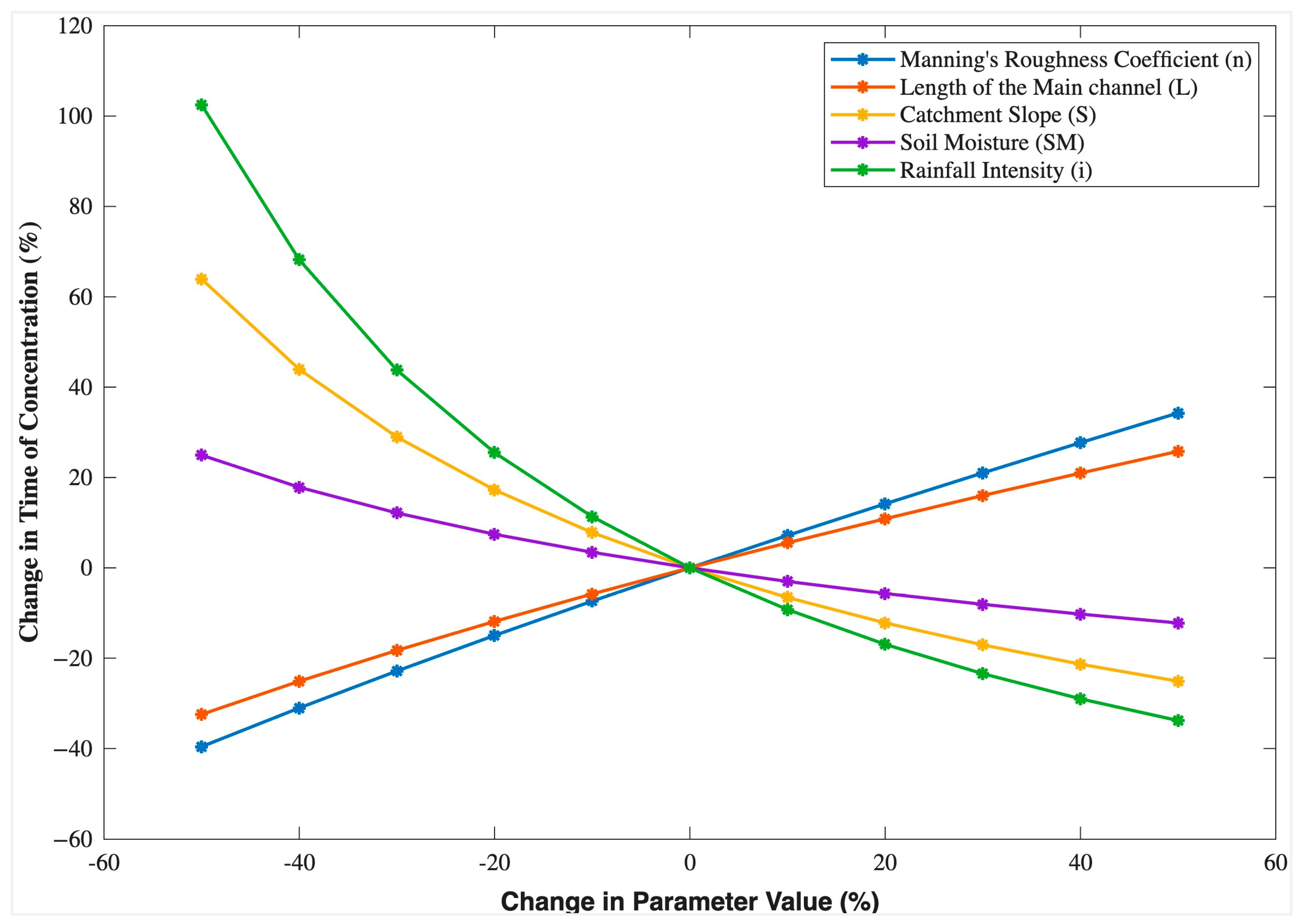
| Dataset | Resolution | Source |
|---|---|---|
| Rainfall | Hourly/Daily | Meteorological Department, Sri Lanka |
| Streamflow | Hourly | Irrigation Department, Sri Lanka |
| SMAP L4 Surface Soil Moisture | 3 hourly (9 km × 9 km) | National Snow and Ice Data Centre Distributed Active Archive Center (NSIDC DAAC), USA |
| Digital Elevation Model | 30 m × 30 m | Shuttle Radar Topography Mission (SRTM) 1 Arc second Global Data |
| Extreme Events | Moderate Events | Low Events | |||||
|---|---|---|---|---|---|---|---|
| Date | Rainfall (mm/day) | Date | Rainfall (mm/day) | Date | Rainfall (mm/day) | Date | Rainfall (mm/day) |
| 08/29/2019 | 137 | 04/01/2015 | 51 | 12/22/2019 | 47 | 05/31/2015 | 31 |
| 05/15/2020 | 155 | 08/04/2015 | 51 | 05/05/2020 | 44 | 12/26/2017 | 28 |
| 06/03/2021 | 147 | 08/17/2015 | 52 | 07/21/2022 | 44 | 07/09/2020 | 28 |
| 08/31/2022 | 247 | 01/08/2016 | 44 | 01/06/2023 | 52 | 07/16/2020 | 29 |
| 06/01/2023 | 183 | 07/29/2016 | 47 | 02/11/2023 | 49 | ||
| 09/29/2016 | 45 | 07/07/2023 | 47 | ||||
| 03/20/2017 | 44 | 04/28/2023 | 53 | ||||
| 08/01/2017 | 41 | ||||||
| Event Category | Extreme | Moderate | Low |
|---|---|---|---|
| Event Date | 29/8/2019 | 1/4/2015 | 26/12/2017 |
| Rainfall Intensity (mm/day) | 137 | 51 | 28 |
| Lmin (hr) | 9 | 21 | 31 |
| Time Lag (Tp) (h) | 4 | 10 | 15 |
| Time of Concentration (Tc) (h) | 6.67 | 16.67 | 25 |
| Estimation Method | Conventional NRCS-SCS Equation | Modified Kinematic Wave Formula (Equation (12)) | Difference Between the Two Methods (%) |
|---|---|---|---|
| Calibration Event: 15 to 17 May 2020 | |||
| Tc (min) | 255 | 160 | −37 |
| Observed peak flow (m3/s) | 167 | 167 | - |
| Simulated peak flow (m3/s) | 163 | 231 | 42 |
| Percentage difference in peak flow simulation | −3% | 38% | - |
| Observed time to peak (min) | 780 | 780 | - |
| Simulated time to peak (min) | 600 | 540 | −10 |
| NSE | 0.87 | 0.13 | −85 |
| PBIAS (%) | 6.6 | 44.3 | 576 |
| NSE | 0.87 | 0.13 | −85 |
| PBIAS (%) | 6.6 | 44.3 | 576 |
| Validation Event: 31 August to 3 September 2022 | |||
| Tc (min) | 255 | 143 | −44 |
| Observed peak flow (m3/s) | 270 | 270 | - |
| Simulated peak flow (m3/s) | 272 | 415 | 53 |
| Percentage difference in peak flow simulation | 1% | 54% | - |
| Observed time to peak (min) | 1740 | 1740 | - |
| Simulated time to peak (min) | 660 | 1,380 | 109 |
| NSE | 0.91 | 0.04 | −95 |
| PBIAS (%) | −6.9 | 36.8 | −632 |
| NSE | 0.91 | 0.04 | −95 |
| PBIAS (%) | −6.9 | 36.8 | −632 |
Disclaimer/Publisher’s Note: The statements, opinions and data contained in all publications are solely those of the individual author(s) and contributor(s) and not of MDPI and/or the editor(s). MDPI and/or the editor(s) disclaim responsibility for any injury to people or property resulting from any ideas, methods, instructions or products referred to in the content. |
© 2025 by the authors. Licensee MDPI, Basel, Switzerland. This article is an open access article distributed under the terms and conditions of the Creative Commons Attribution (CC BY) license (https://creativecommons.org/licenses/by/4.0/).
Share and Cite
Bandara, K.; Pabasara, K.; Gunawardhana, L.; Bamunawala, J.; Sirisena, J.; Rajapakse, L. Coupling Rainfall Intensity and Satellite-Derived Soil Moisture for Time of Concentration Prediction: A Data-Driven Hydrological Approach to Enhance Climate Responsiveness. Hydrology 2025, 12, 264. https://doi.org/10.3390/hydrology12100264
Bandara K, Pabasara K, Gunawardhana L, Bamunawala J, Sirisena J, Rajapakse L. Coupling Rainfall Intensity and Satellite-Derived Soil Moisture for Time of Concentration Prediction: A Data-Driven Hydrological Approach to Enhance Climate Responsiveness. Hydrology. 2025; 12(10):264. https://doi.org/10.3390/hydrology12100264
Chicago/Turabian StyleBandara, Kasun, Kavini Pabasara, Luminda Gunawardhana, Janaka Bamunawala, Jeewanthi Sirisena, and Lalith Rajapakse. 2025. "Coupling Rainfall Intensity and Satellite-Derived Soil Moisture for Time of Concentration Prediction: A Data-Driven Hydrological Approach to Enhance Climate Responsiveness" Hydrology 12, no. 10: 264. https://doi.org/10.3390/hydrology12100264
APA StyleBandara, K., Pabasara, K., Gunawardhana, L., Bamunawala, J., Sirisena, J., & Rajapakse, L. (2025). Coupling Rainfall Intensity and Satellite-Derived Soil Moisture for Time of Concentration Prediction: A Data-Driven Hydrological Approach to Enhance Climate Responsiveness. Hydrology, 12(10), 264. https://doi.org/10.3390/hydrology12100264








